2006 DODGE RAM SRT-10 engine
[x] Cancel search: enginePage 1957 of 5267
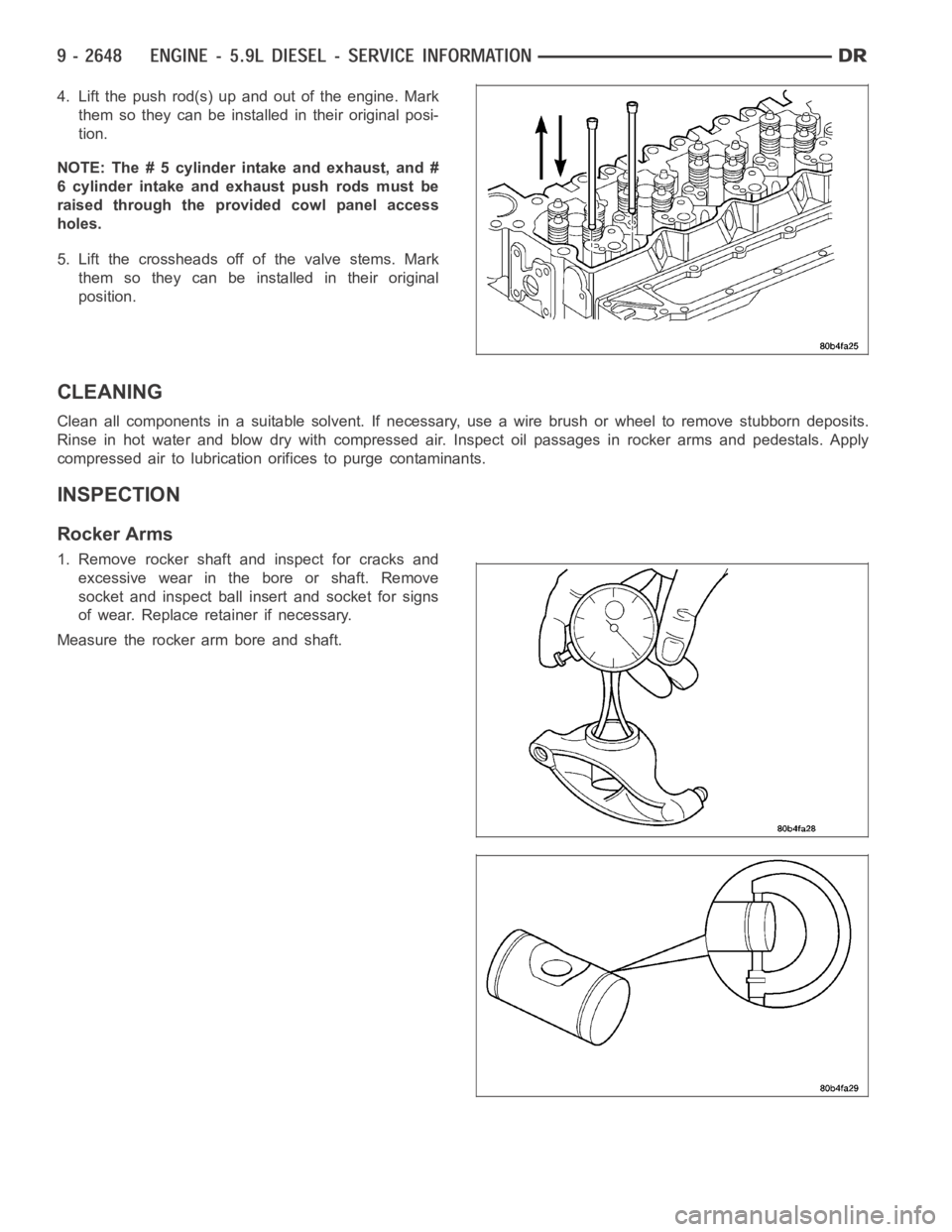
4. Lift the push rod(s) up and out of the engine. Mark
them so they can be installed in their original posi-
tion.
NOTE: The # 5 cylinder intake and exhaust, and #
6 cylinder intake and exhaust push rods must be
raised through the provided cowl panel access
holes.
5. Lift the crossheads off of the valve stems. Mark
them so they can be installed in their original
position.
CLEANING
Clean all components in a suitable solvent. If necessary, use a wire brush or wheel to remove stubborn deposits.
Rinse in hot water and blow dry with compressed air. Inspect oil passages inrocker arms and pedestals. Apply
compressed air to lubrication orifices to purge contaminants.
INSPECTION
Rocker Arms
1. Remove rocker shaft and inspect for cracks and
excessive wear in the bore or shaft. Remove
socket and inspect ball insert and socket for signs
of wear. Replace retainer if necessary.
Measure the rocker arm bore and shaft.
Page 1958 of 5267
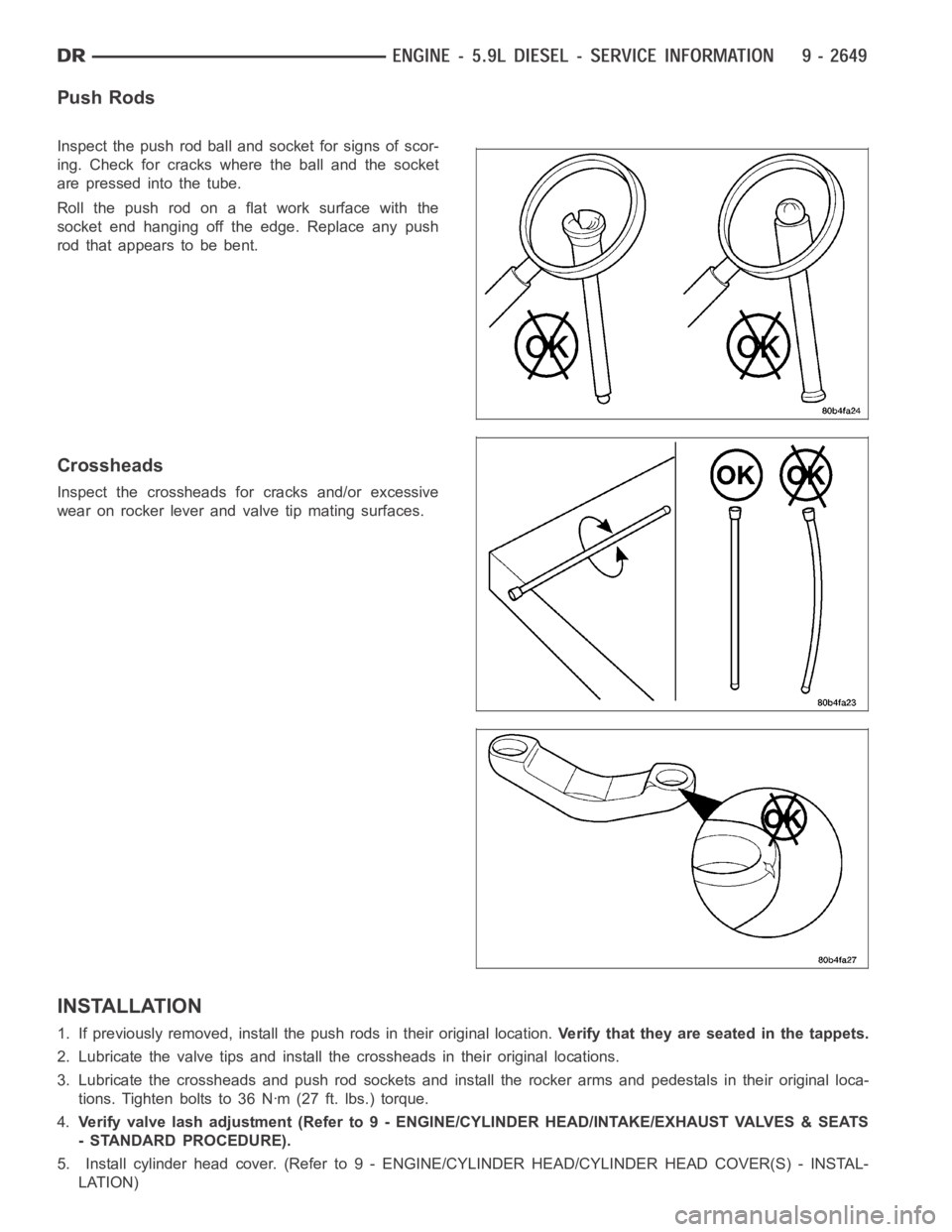
Push Rods
Inspect the push rod ball and socket for signs of scor-
ing. Check for cracks where the ball and the socket
are pressed into the tube.
Roll the push rod on a flat work surface with the
socket end hanging off the edge. Replace any push
rod that appears to be bent.
Crossheads
Inspect the crossheads for cracks and/or excessive
wear on rocker lever and valve tip mating surfaces.
INSTALLATION
1. If previously removed, install the push rods in their original location.Verify that they are seated in the tappets.
2. Lubricate the valve tips and install the crossheads in their original locations.
3. Lubricate the crossheads and push rod sockets and install the rocker arms and pedestals in their original loca-
tions. Tighten bolts to 36 Nꞏm (27 ft. lbs.) torque.
4.Verify valve lash adjustment (Refer to 9 - ENGINE/CYLINDER HEAD/INTAKE/EXHAUST VALVES & SEATS
- STANDARD PROCEDURE).
5. Install cylinder head cover. (Refer to 9 - ENGINE/CYLINDER HEAD/CYLINDER HEAD COVER(S) - INSTAL-
LATION)
Page 1960 of 5267
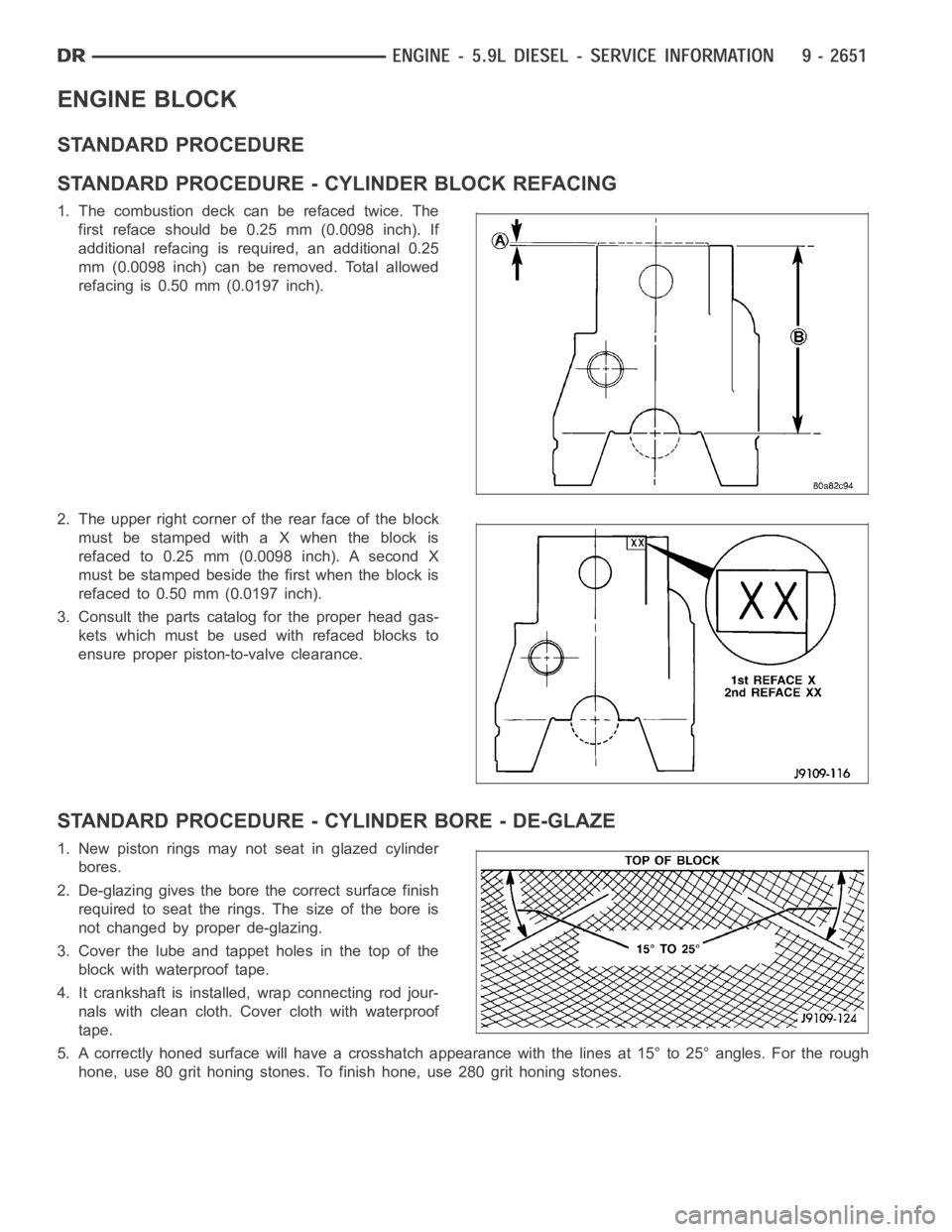
ENGINE BLOCK
STANDARD PROCEDURE
STANDARD PROCEDURE - CYLINDER BLOCK REFACING
1. The combustion deck can be refaced twice. The
first reface should be 0.25 mm (0.0098 inch). If
additional refacing is required, an additional 0.25
mm (0.0098 inch) can be removed. Total allowed
refacing is 0.50 mm (0.0197 inch).
2. The upper right corner of the rear face of the block
must be stamped with a X when the block is
refaced to 0.25 mm (0.0098 inch). A second X
must be stamped beside the first when the block is
refacedto0.50mm(0.0197inch).
3. Consult the parts catalog for the proper head gas-
kets which must be used with refaced blocks to
ensure proper piston-to-valve clearance.
STANDARD PROCEDURE - CYLINDER BORE - DE-GLAZE
1. New piston rings may not seat in glazed cylinder
bores.
2. De-glazing gives the bore the correct surface finish
required to seat the rings. The size of the bore is
not changed by proper de-glazing.
3. Cover the lube and tappet holes in the top of the
block with waterproof tape.
4. It crankshaft is installed, wrap connecting rod jour-
nals with clean cloth. Cover cloth with waterproof
tape.
5. A correctly honed surface will have a crosshatch appearance with the lines at 15° to 25° angles. For the rough
hone, use 80 grit honing stones. To finish hone, use 280 grit honing stones.
Page 1961 of 5267
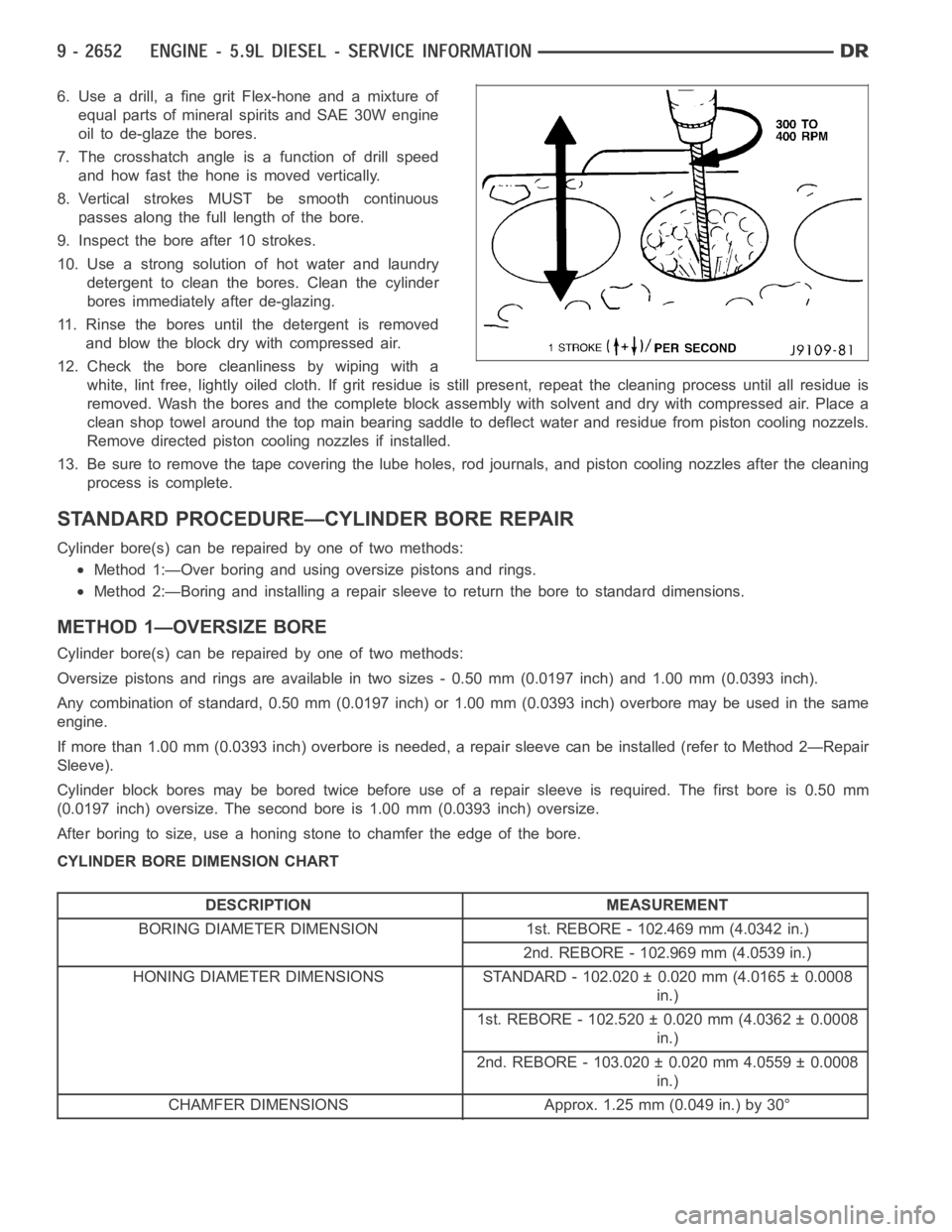
6. Use a drill, a fine grit Flex-hone and a mixture of
equal parts of mineral spirits and SAE 30W engine
oil to de-glaze the bores.
7. The crosshatch angle is a function of drill speed
and how fast the hone is moved vertically.
8. Vertical strokes MUST be smooth continuous
passes along the full length of the bore.
9. Inspect the bore after 10 strokes.
10. Use a strong solution of hot water and laundry
detergent to clean the bores. Clean the cylinder
bores immediately after de-glazing.
11. Rinse the bores until the detergent is removed
and blow the block dry with compressed air.
12. Check the bore cleanliness by wiping with a
white, lint free, lightly oiled cloth. If grit residue is still present, repeat the cleaning process until all residue is
removed. Wash the bores and the complete block assembly with solvent and dry with compressed air. Place a
clean shop towel around the top main bearing saddle to deflect water and residue from piston cooling nozzels.
Remove directed piston cooling nozzles if installed.
13. Be sure to remove the tape covering the lube holes, rod journals, and piston cooling nozzles after the cleaning
process is complete.
STANDARD PROCEDURE—CYLINDER BORE REPAIR
Cylinder bore(s) can be repaired by one of two methods:
Method 1:—Over boring and using oversize pistons and rings.
Method 2:—Boring and installing a repair sleeve to return the bore to standard dimensions.
METHOD 1—OVERSIZE BORE
Cylinder bore(s) can be repaired by one of two methods:
Oversize pistons and rings are available in two sizes - 0.50 mm (0.0197 inch) and 1.00 mm (0.0393 inch).
Any combination of standard, 0.50 mm (0.0197 inch) or 1.00 mm (0.0393 inch)overbore may be used in the same
engine.
If more than 1.00 mm (0.0393 inch) overbore is needed, a repair sleeve can beinstalled (refer to Method 2—Repair
Sleeve).
Cylinder block bores may be bored twice before use of a repair sleeve is required. The first bore is 0.50 mm
(0.0197 inch) oversize. The second bore is 1.00 mm (0.0393 inch) oversize.
After boring to size, use a honing stone to chamfer the edge of the bore.
CYLINDER BORE DIMENSION CHART
DESCRIPTION MEASUREMENT
BORING DIAMETER DIMENSION 1st. REBORE - 102.469 mm (4.0342 in.)
2nd. REBORE - 102.969 mm (4.0539 in.)
HONING DIAMETER DIMENSIONS STANDARD - 102.020 ± 0.020 mm (4.0165 ± 0.0008
in.)
1st. REBORE - 102.520 ± 0.020 mm (4.0362 ± 0.0008
in.)
2nd. REBORE - 103.020 ± 0.020 mm 4.0559 ± 0.0008
in.)
CHAMFER DIMENSIONS Approx. 1.25 mm (0.049 in.) by 30°
Page 1964 of 5267
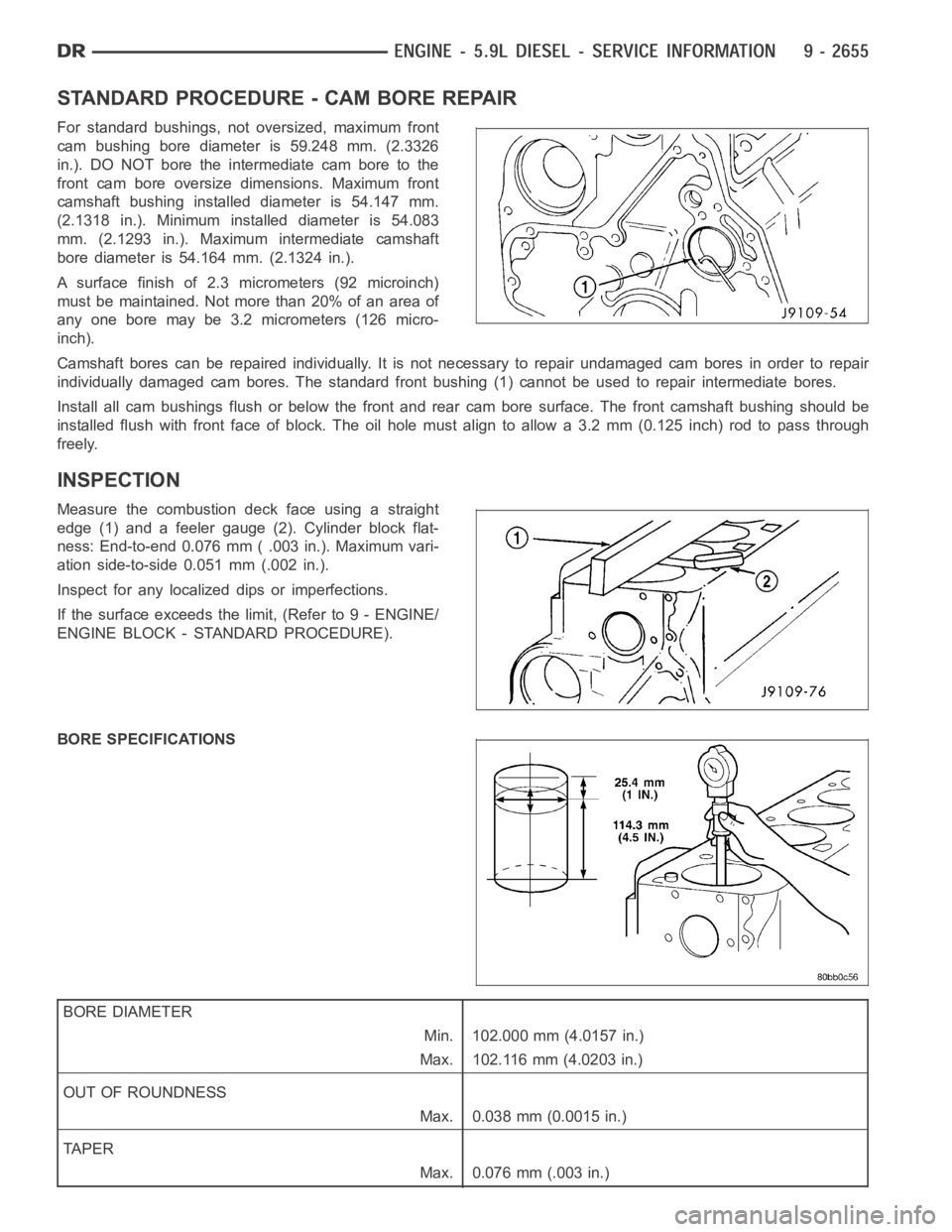
STANDARD PROCEDURE - CAM BORE REPAIR
For standard bushings, not oversized, maximum front
cam bushing bore diameter is 59.248 mm. (2.3326
in.). DO NOT bore the intermediate cam bore to the
front cam bore oversize dimensions. Maximum front
camshaft bushing installed diameter is 54.147 mm.
(2.1318 in.). Minimum installed diameter is 54.083
mm. (2.1293 in.). Maximum intermediate camshaft
bore diameter is 54.164 mm. (2.1324 in.).
A surface finish of 2.3 micrometers (92 microinch)
must be maintained. Not more than 20% of an area of
any one bore may be 3.2 micrometers (126 micro-
inch).
Camshaft bores can be repaired individually. It is not necessary to repairundamaged cam bores in order to repair
individually damaged cam bores. The standard front bushing (1) cannot be used to repair intermediate bores.
Install all cam bushings flush or below the front and rear cam bore surface.The front camshaft bushing should be
installed flush with front face of block. The oil hole must align to allow a 3.2 mm (0.125 inch) rod to pass through
freely.
INSPECTION
Measure the combustion deck face using a straight
edge (1) and a feeler gauge (2). Cylinder block flat-
ness: End-to-end 0.076 mm ( .003 in.). Maximum vari-
ation side-to-side 0.051 mm (.002 in.).
Inspect for any localized dips or imperfections.
If the surface exceeds the limit, (Refer to 9 - ENGINE/
ENGINE BLOCK - STANDARD PROCEDURE).
BORE SPECIFICATIONS
BORE DIAMETER
Min. 102.000 mm (4.0157 in.)
Max. 102.116 mm (4.0203 in.)
OUT OF ROUNDNESS
Max. 0.038 mm (0.0015 in.)
TA P E R
Max. 0.076 mm (.003 in.)
Page 1965 of 5267
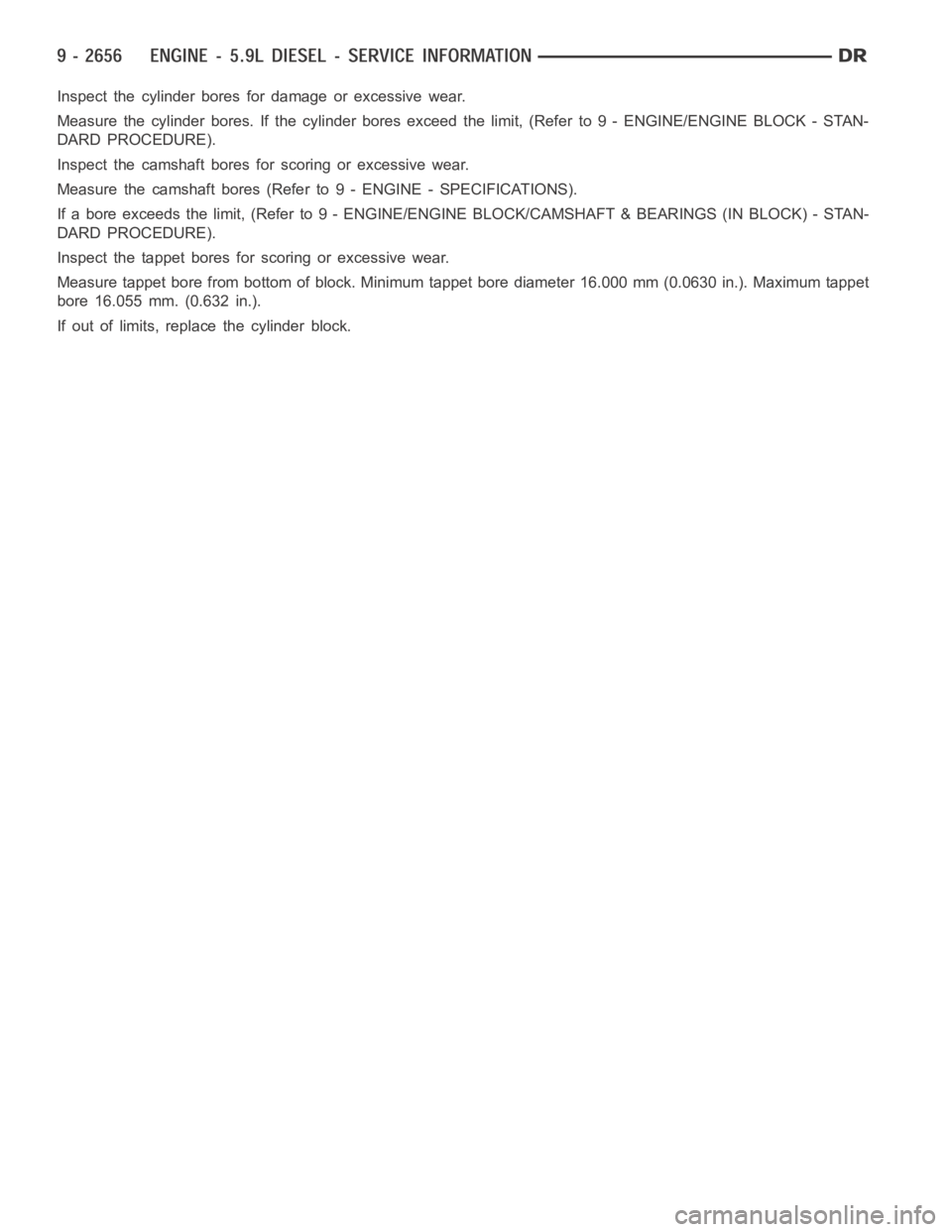
Inspect the cylinder bores for damage or excessive wear.
Measure the cylinder bores. If the cylinder bores exceed the limit, (Referto 9 - ENGINE/ENGINE BLOCK - STAN-
DARD PROCEDURE).
Inspect the camshaft bores for scoring or excessive wear.
Measure the camshaft bores (Refer to 9 - ENGINE - SPECIFICATIONS).
If a bore exceeds the limit, (Refer to 9 - ENGINE/ENGINE BLOCK/CAMSHAFT & BEARINGS (IN BLOCK) - STAN-
DARD PROCEDURE).
Inspect the tappet bores for scoring or excessive wear.
Measure tappet bore from bottom of block. Minimum tappet bore diameter 16.000 mm (0.0630 in.). Maximum tappet
bore 16.055 mm. (0.632 in.).
If out of limits, replace the cylinder block.
Page 1966 of 5267
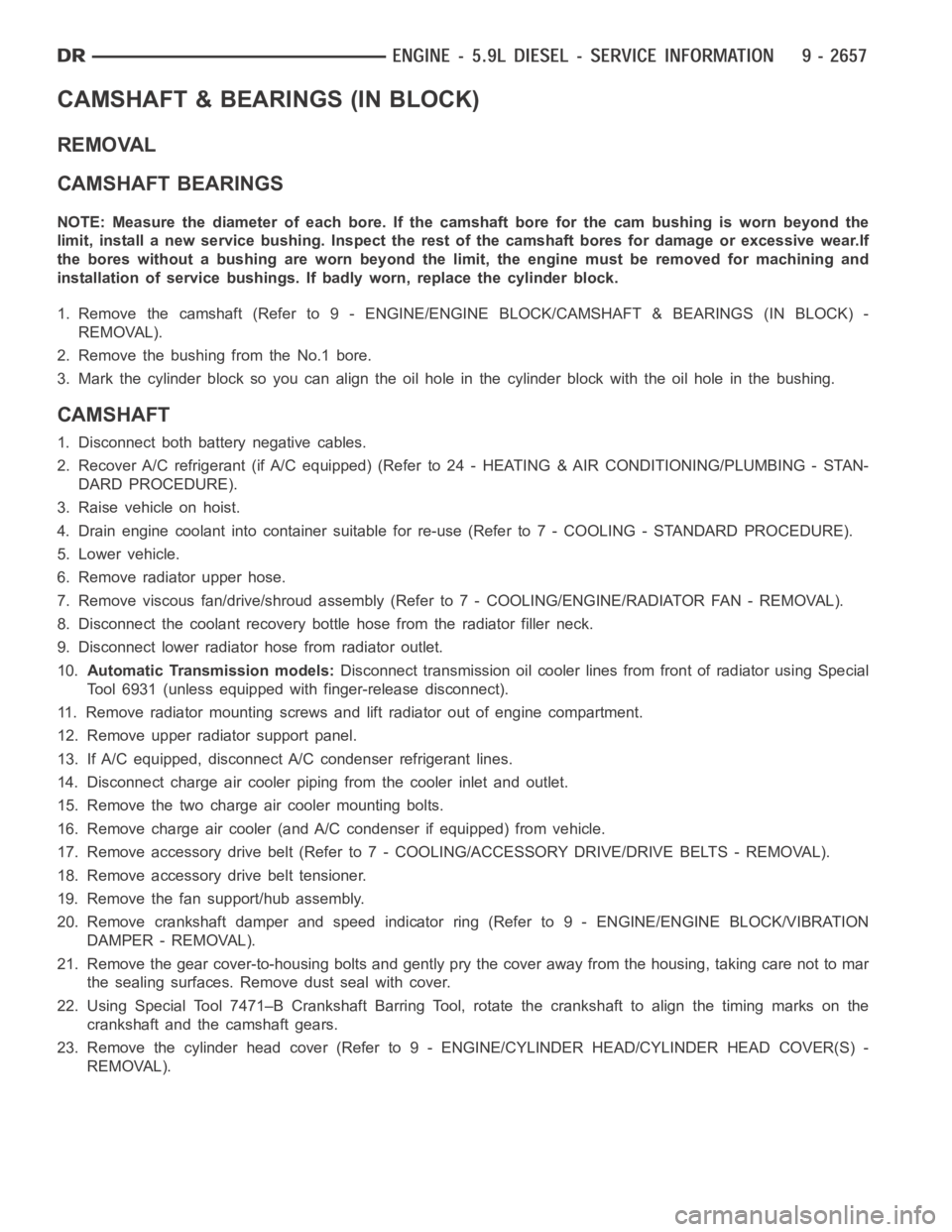
CAMSHAFT & BEARINGS (IN BLOCK)
REMOVAL
CAMSHAFT BEARINGS
NOTE: Measure the diameter of each bore. If the camshaft bore for the cam bushing is worn beyond the
limit, install a new service bushing. Inspect the rest of the camshaft bores for damage or excessive wear.If
the bores without a bushing are worn beyond the limit, the engine must be removed for machining and
installation of service bushings. If badly worn, replace the cylinder block.
1. Remove the camshaft (Refer to 9 - ENGINE/ENGINE BLOCK/CAMSHAFT & BEARINGS (IN BLOCK) -
REMOVAL).
2. Remove the bushing from the No.1 bore.
3. Mark the cylinder block so you can align the oil hole in the cylinder blockwith the oil hole in the bushing.
CAMSHAFT
1. Disconnect both battery negative cables.
2. Recover A/C refrigerant (if A/C equipped) (Refer to 24 - HEATING & AIR CONDITIONING/PLUMBING - STAN-
DARD PROCEDURE).
3. Raise vehicle on hoist.
4. Drain engine coolant into container suitable for re-use (Refer to 7 - COOLING - STANDARD PROCEDURE).
5. Lower vehicle.
6. Remove radiator upper hose.
7. Remove viscous fan/drive/shroud assembly (Refer to 7 - COOLING/ENGINE/RADIATOR FAN - REMOVAL).
8. Disconnect the coolant recovery bottle hose from the radiator filler neck.
9. Disconnect lower radiator hose from radiator outlet.
10.Automatic Transmission models:Disconnect transmission oil cooler lines from front of radiator using Special
Tool 6931 (unless equipped with finger-release disconnect).
11. Remove radiator mounting screws and lift radiator out of engine compartment.
12. Remove upper radiator support panel.
13. If A/C equipped, disconnect A/C condenser refrigerant lines.
14. Disconnect charge air cooler piping from the cooler inlet and outlet.
15. Remove the two charge air cooler mounting bolts.
16. Remove charge air cooler (and A/C condenser if equipped) from vehicle.
17. Remove accessory drive belt (Refer to 7 - COOLING/ACCESSORY DRIVE/DRIVE BELTS - REMOVAL).
18. Remove accessory drive belt tensioner.
19. Remove the fan support/hub assembly.
20. Remove crankshaft damper and speed indicator ring (Refer to 9 - ENGINE/ENGINE BLOCK/VIBRATION
DAMPER - REMOVAL).
21. Remove the gear cover-to-housing bolts and gently pry the cover away from the housing, taking care not to mar
the sealing surfaces. Remove dust seal with cover.
22. Using Special Tool 7471–B Crankshaft Barring Tool, rotate the crankshaft to align the timing marks on the
crankshaft and the camshaft gears.
23. Remove the cylinder head cover (Refer to 9 - ENGINE/CYLINDER HEAD/CYLINDER HEAD COVER(S) -
REMOVAL).
Page 1967 of 5267
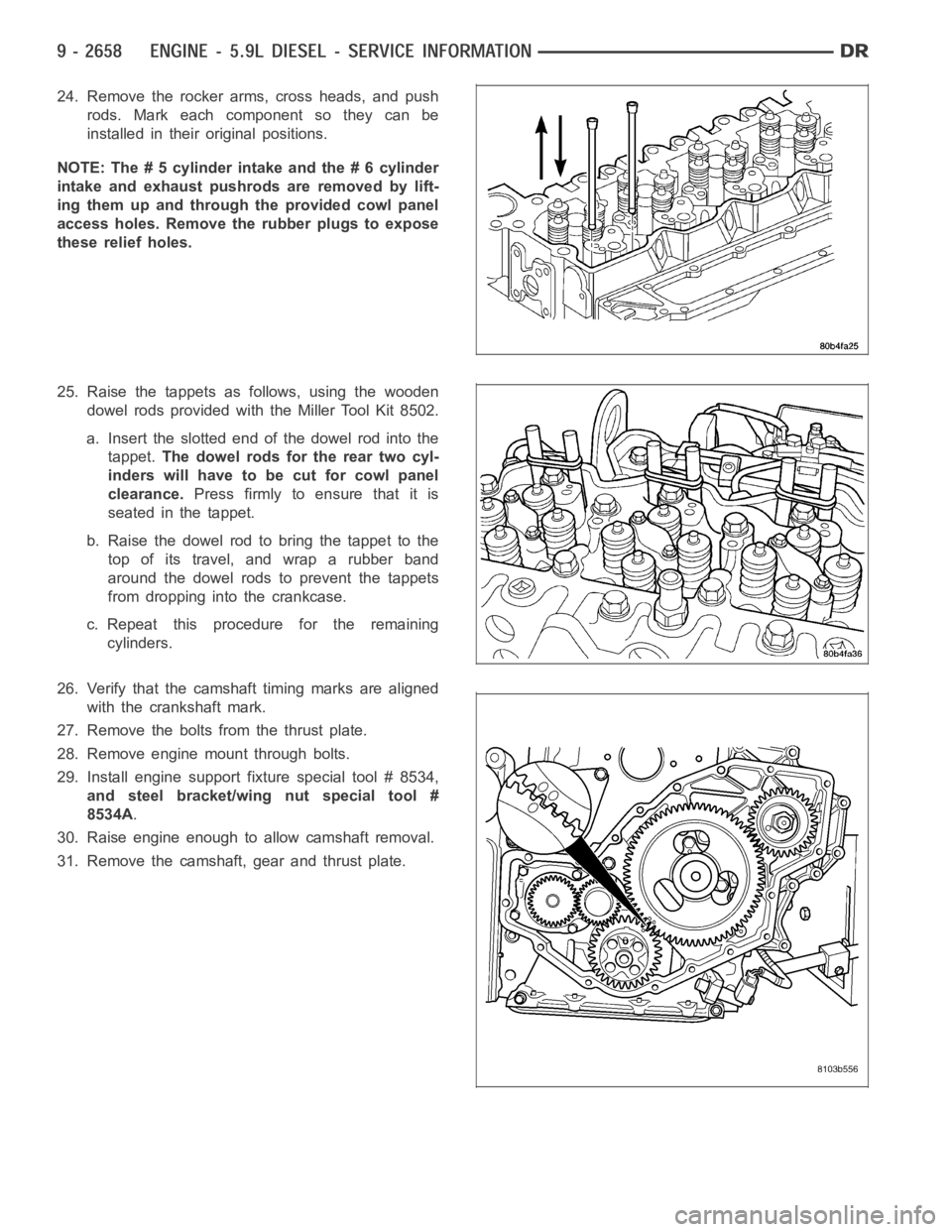
24. Remove the rocker arms, cross heads, and push
rods. Mark each component so they can be
installed in their original positions.
NOTE: The # 5 cylinder intake and the # 6 cylinder
intake and exhaust pushrods are removed by lift-
ing them up and through the provided cowl panel
access holes. Remove the rubber plugs to expose
these relief holes.
25. Raise the tappets as follows, using the wooden
dowel rods provided withthe Miller Tool Kit 8502.
a. Insert the slotted end of the dowel rod into the
tappet.The dowel rods for the rear two cyl-
inders will have to be cut for cowl panel
clearance.Press firmly to ensure that it is
seated in the tappet.
b. Raise the dowel rod to bring the tappet to the
top of its travel, and wrap a rubber band
around the dowel rods to prevent the tappets
from dropping into the crankcase.
c. Repeat this procedure for the remaining
cylinders.
26. Verify that the camshaft timing marks are aligned
with the crankshaft mark.
27. Remove the bolts from the thrust plate.
28. Remove engine mount through bolts.
29. Install engine support fixture special tool # 8534,
and steel bracket/wing nut special tool #
8534A.
30. Raise engine enough to allow camshaft removal.
31. Remove the camshaft, gear and thrust plate.